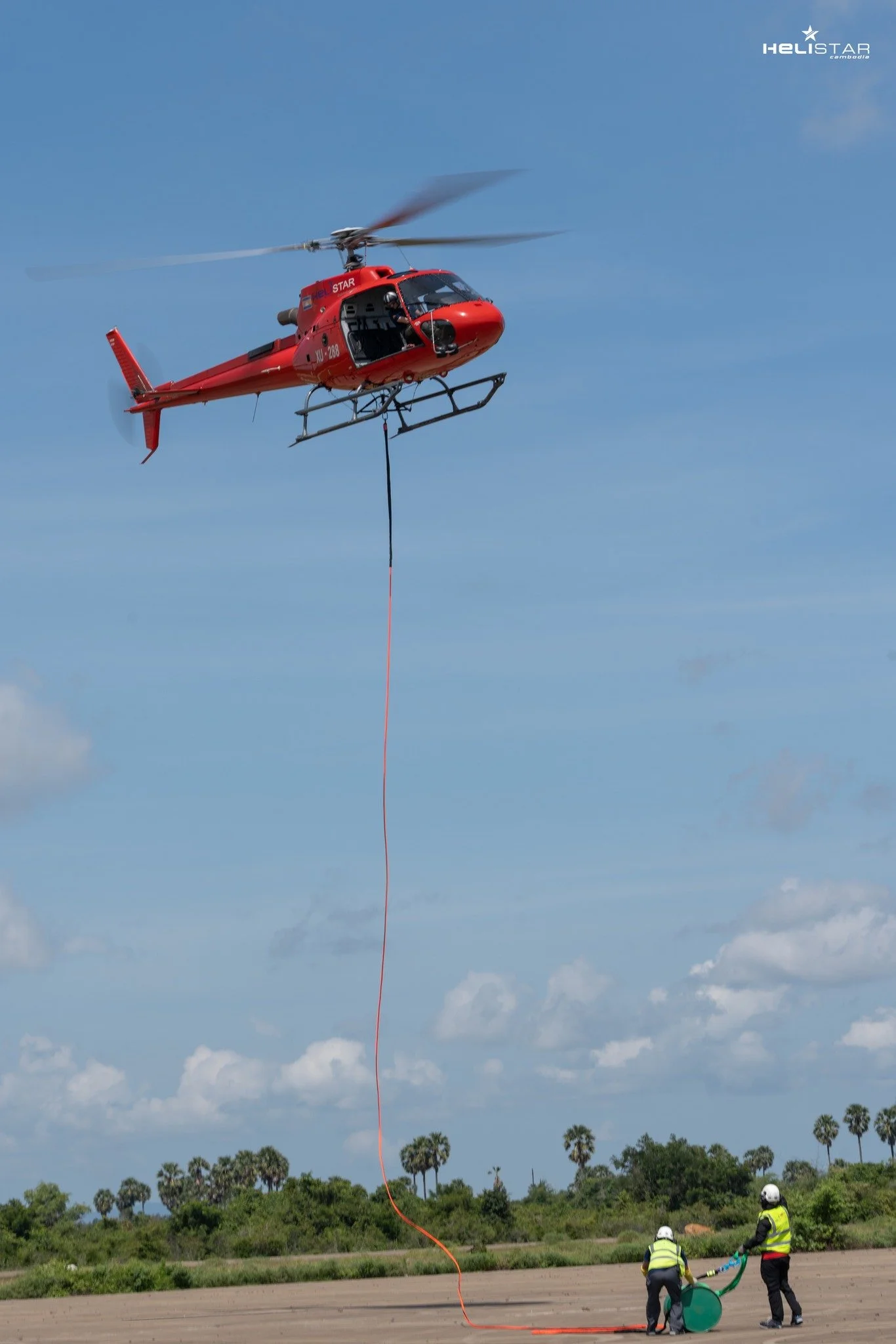
Bringing you logistical peace of mind with over 1,000Kg in lifting capacity
External Sling Load operations
Lifting the kingdoms potential
Helistar Cambodia is proud to be the only certified helicopter lifting and external load operator in the Kingdom of Cambodia, and only recently so! Meaning this is a new venture, opportunity and era for Cambodian logistics.
We are able to provide our services to both government and private individuals and businesses requiring items and cargo to be lifted to hard to reach areas, up to a maximum of 1,100Kg, utilizing a long line of up to 100ft.
Why use a Helicopter instead of a crane?
-
This is the single biggest advantage. A helicopter doesn't need roads, cleared paths, or a solid foundation.
Remote and Difficult Terrain: Helicopters can place equipment on mountain tops, deep in forests, across rivers, or in swampy, marshy areas where it would be impossible to transport and assemble a crane.
Urban Canyons: In dense cities, a helicopter can lift materials directly onto a skyscraper roof or into a tight courtyard without blocking streets for days to set up a crane.
Over Obstacles: A helicopter can fly over active highways, power lines, buildings, and other infrastructure that would be a major obstacle for a ground-based crane.
Example: Transporting a new HVAC unit to the roof of a 30-story building in downtown Manhattan or placing a communication antenna on a remote mountain.
-
For many specialized jobs, a helicopter is dramatically faster.
Rapid Mobilization: A helicopter can arrive on-site, complete the lift, and be gone in a matter of hours. Transporting, assembling, and disassembling a large crane can take several days.
Reduced Project Timelines: This speed minimizes downtime for other operations. For instance, if you're replacing a critical component on a power line or a factory, the aerial lift can get the job done in a single window, reducing operational losses.
Example: Lifting bundles of steel or concrete into place for a bridge repair in a single day, versus a week of setup and work with a crane.
-
Because the helicopter operates from the air, the impact on the ground below is virtually zero.
No Foundation Needed: Large cranes require a stable, often concrete, foundation and extensive ground preparation. A helicopter needs only a small, safe staging area for the load and a place to land.
Environmental Protection: In sensitive ecosystems like wetlands or national parks, a helicopter allows work to be done without building roads or clearing land, preventing erosion and habitat destruction.
Reduced Traffic and Noise: A helicopter lift is a short-term event. A crane setup can cause major road closures and disruption for an extended period.
Example: Installing a sensor in a delicate wetland area without damaging the surrounding flora and fauna.
-
With a skilled pilot and an experienced ground crew, a helicopter can place objects with remarkable accuracy.
360-Degree Access: A helicopter can approach a lift point from any direction, which is impossible for a fixed crane. This is invaluable for complex rooftop installations.
"Long-line" Precision: By using a long cable (a "long-line"), the pilot can hover high above an obstacle (like trees or a building) and lower the load precisely into position, with ground crews guiding it with taglines.
Example: Carefully lowering a large statue onto its pedestal in the middle of a fenced garden.
-
While the hourly rate for a helicopter is very high, the total project cost can sometimes be lower.
Eliminates Ancillary Costs: You save money on road building, foundation pouring, crane transport, permits for road closures, and the large crew needed for crane assembly and operation.
Economies of Speed: For short, difficult lifts, the immense speed can offset the high hourly rate, especially when time is a critical factor.
“Up to 1.1 tons (1,100kg) lifting capacity”
Summary / Comparison
A summary and comparison for some of the major factors of using a helicopter verses a crane
Factor
Accessibility
Setup speed
Ground Disruption
Lift Capacity
Weather Dependance
Best for
Helicopters
Excellent: can go anywhere
Very fast: Hours
Minimal: small staging area
Limited: Up to 1,100kg
High: Sensitive to wind
Remote sites urban rooftops sensitive environments and fast specialized lifts
Crane
Limited: Requires ground access and space
Slow: Days for large cranes
High: requires foundations ,road closures
Massive: 100’s of ton’s
Low: Can operate in most weather
Large-scale construction heavy lifts and projects with good site access.


